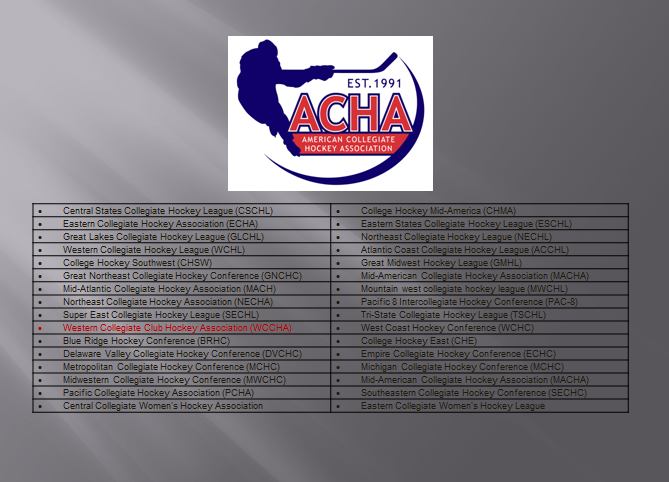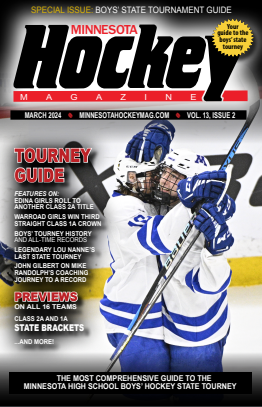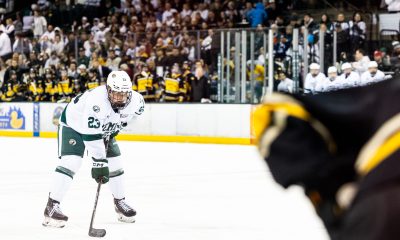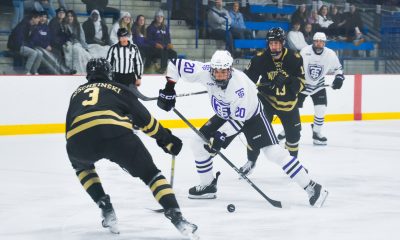
Featured image – ACHA conferences blanket the country. Club hockey teams can be found at a college or university near you. All you need to do is look!
MHM worked this year to give more exposure to college club hockey, an often overlooked segment of what we call the great hockey pyramid. The WCCHA is alive and well, and with the season now over, MHM wanted to step back and explore the state of college club hockey across the country and right here in MN. In this Q&A session, we ask Ryan Donovan, Commissioner of the WCCHA conference and member of the ACHA Central region, questions about the growing interest in college club hockey across the country.
Q. MHM. Club hockey is a great alternative to varsity college hockey in the US. Many people don’t understand how well it is organized. What is the governing body of non-varsity college hockey, what is its role and where do you think it is going?
A. Ryan. First and foremost, the premier club hockey – referred to in some circles as “non-varsity” – national governing body is the American Collegiate Hockey Association (ACHA). Having officially been founded in 1991, the ACHA governs intercollegiate competition and hosts regional and national competitions for its members. The ACHA partners with and registers all players with USA Hockey, and is affiliated with other major organizations like the American Hockey Coaches Association. The ACHA seems to fill a void left in the hockey world due to the constraints on adding teams in the NCAA (whether budgetary or related to Title IX) or the lack of official competition for NAIA schools. As some of those realities are not likely to change anytime soon, the ACHA is poised to continue to grow and become a bigger player in the collegiate hockey scene.
Q. MHM. How big is club hockey in the US and does it offer opportunities for both men and women?
A. Ryan. The ACHA has grown from 15 teams in 1991 to 450 today across five divisions – three men’s divisions and two for women. There are registered teams from 49 of the 50 states, with Hawaii being the only exception. Here in Minnesota, there are a number of men’s and women’s teams, from large schools like the University of Minnesota (both men’s and women’s) in the Twin Cities to smaller schools like Rainy River Community College in International Falls (women’s – 3 time national champions). For perspective, however, club hockey tends to be the highest level of play available in most areas of the country. NCAA programs – both DI and DIII – are somewhat limited to the Midwest and the East. So, many schools elsewhere have found success fielding ACHA teams. For example, the University of Arizona routinely sees 3,000 fans at home games, which puts them in the top 25 in attendance for all of college hockey (source: http://www.wildcat.arizona.edu/article/2012/10/arizona-hockey-season-102412). And, yet, it’s the “smaller” programs that really provide the greatest opportunity for college students looking to play competitive, intercollegiate hockey while getting their degree.
Q. MHM. Why do you think it has grown so popular so rapidly?
A. Ryan. It definitely comes down to demand. First, we know it’s not easy for NCAA schools – either DI or DIII – to add a sport like hockey, and the NAIA does not have an official competition for hockey. Thus, some schools turn to the ACHA for their official team. On the other hand, we see NCAA schools that have students who are not playing varsity but still interested in skating competitively in college. For these schools and their students, fielding a “second” team through the club or recreational sports department is a no-brainer.
Q. MHM. College hockey programs at the varsity level are pretty expensive. What level of support do the colleges and universities provide these club teams? Is there a cost to the student athletes?
A. Ryan. It very much depends on the school – this is the biggest variable between ACHA teams across the country. For the most part, ACHA teams are organized as part of a school’s recreational or club sports department, not the athletic department. In general, these offices only provide some, if any, financial support to the teams. Thus, it’s left up to the team/players to provide the necessary funds for competition, whether through player dues, admissions, fundraising – or most likely, a combination of many things. Unfortunately, we know hockey is expensive. Depending on the school, then, players likely pay anywhere from $500-$4000 to participate – some with a contribution from the school, others not. There are other variables as well, such as ice costs. Locally, though, I’d say programs here in Minnesota are on the lower end of that range.
Q. MHM. What do the game schedules typically look like? How long is the season, how many games, etc.? Do they have playoffs and post-season tournaments?
A. Ryan. Teams typically play anywhere from 20-35 games. Unlike the NCAA, the ACHA starts competition pretty early – mid-September for most schools – and runs through the National Tournaments in March. Most teams play games on the weekends to avoid conflicts with academics. There is no requirement to participate in a conference, but many teams do. The Western Collegiate Club Hockey Association (WCCHA), for example, includes member schools from Minnesota and Wisconsin, and plays a full conference schedule and end-of-season tournament. Teams that earn regional ranking recognition may earn an invitation to ACHA Regionals, which can lead to a birth in the National Tournament. There is definitely plenty to play for.
Q. MHM. How many teams play in the WCCHA and how many are from MN? What are they?
A. Ryan. The WCCHA has had as many as 6 teams from Minnesota, but the current iteration has 3 – the University of Minnesota-Twin Cities, St. Cloud State University and the University of St. Thomas. In addition, the league has two teams from Wisconsin – Wisconsin-Eau Claire and Wisconsin-Madison. At one time, Minnesota State-Mankato, St. Olaf College and the University of Minnesota-Duluth were members of the WCCHA.
Q. MHM. So how many Minnesota colleges or universities have club hockey?
A. Ryan. To my knowledge, the following schools have ACHA teams (and if they are in/entering a conference, it is listed):
University of Minnesota (WCCHA)
University of MInnesota-Duluth (NCHL)
Bemidji State University
St. Cloud State University (WCCHA)
University of St. Thomas (WCCHA)
Minnesota State University-Mankato
Winona State University
St. Mary’s University (NCHL)
There are also some schools that are non-ACHA, but still have club teams (this list may not be exhaustive):
Bethel University
St. Olaf College
Carleton College
Macalaester College
In addition, there are also some “border” teams like UW-Superior, UW-Eau Claire, UW-La Crosse, South Dakota State, North Dakota State and (possibly new next year) North Dakota.
Q. MHM. Has the membership of the WCCHA changed very often? Any new teams coming in from MN or other states?
A. Ryan. Perhaps one of the pain points of club hockey is consistency. Because most of these teams are student run, it can be tough for some teams to maintain a certain level year in, year out. For this reason, we have seen some turnover – something I do my best to help avoid – over our now 11 year history. At times, members have included teams from the upper peninsula of Michigan and Iowa. Due to logistics, we will not be adding any new full members for 2014-2015. However, we are in discussions with a number of interested programs in Minnesota, North Dakota and Wisconsin, and I’m really excited at the possibility of growing the league.
Q. MHM. Are there any women’s club hockey teams in MN? Are they also part of the ACHA structure?
A. Ryan. Absolutely – and we have some of the best! Each division (men’s DI, DII, DIII and women’s DI and DII) has its own leadership and can pass its own competition rules. I haven’t been very involved with the women’s side, but teams like the University of Minnesota and Rainy River CC have won national championships very recently. Minnesota-Duluth also has a solid program, and there are teams in North Dakota, South Dakota and Wisconsin that field many players who grew up playing here.
Q. MHM. From a competitive point of view, how does the WCCHA stack up against the other Central region conferences and Division II conferences from other regions? Is there a particularly strong or dominant Division II conference in the US?
A. Ryan. From an individual talent perspective, the WCCHA is as good as any league in the country – we showed that last year with impressive results at the ACHA D2 All-Star Challenge, which was a tournament featuring conference “all-star” teams. However, when it comes to regional accolades and results, we’re a bit behind leagues such as the Mid-American Collegiate Hockey Association (MACHA) and the Great Midwest Hockey League (GMHL); the MACHA hosts teams from Iowa, Illinois and Missouri while the GMHL has teams from Michigan and Ohio. But in general, WCCHA members don’t have the same financial backing as some of the teams they compete against, so it can be an uphill battle. Yet, teams like St. Cloud State and St. Thomas have shown well in recent seasons and earned trips to Regionals, with St. Thomas coming within a game of a Nationals trip a few years ago. One thing we see in club hockey is a lot of turnover – not just of players, but of how programs operate. Because of that, there really is a fair amount of parity.
Q. MHM. Have any idea how many MN college students are playing club hockey across the US?
A. Ryan. A recent Let’s Play Hockey article did a pretty thorough count – maybe 350 or so between all of the men’s and women’s divisions. That number speaks volumes as to the opportunity this level of hockey presents to the college student interested in playing competitively. When I first played club hockey at the University of Minnesota in 2001, there were two men’s teams in Minnesota and one (now defunct) team in Wisconsin. Since that time, we’ve seen huge growth in the upper Midwest across all divisions, with new teams sprouting up each season. Of course, high school seniors shouldn’t think they are limited to the teams in Minnesota – in fact, that is the beauty of the ACHA. There are great programs like Florida Gulf Coast University, Arizona and Arizona State, the University of Oklahoma and more in “non-traditional” locations should a player be looking for a change as they head to college.
Q. MHM. DI and DIII varsity programs require a major commitment on the part of a player and almost always require 2 years of junior hockey before they can start college. That leaves a lot of good high school and some junior players that want to start their college education right away without a competitive outlet for hockey. Outside of intramurals, it seems like club hockey is a perfect fit for these students. What kind of student/player is typically interested in playing club hockey and what do you see as the main benefit of competing at this level? Any downside or challenges they face?
A. Ryan. Like we’ve discussed, club hockey fills a void. Players are often looking for something more competitive than intramurals, but perhaps have decided not to further pursue juniors, NCAA DI or NCAA DIII – good skaters who are just ready to start college. The commitment is more than intramurals, but generally not quite as high as the varsity squads. Teams may practice once or twice a week instead of four to five times, leaving ample time to balance school and sport. Of course, there is plenty of variability in the ACHA – some teams require a commitment similar to a varsity program – but here in Minnesota, club hockey is really about providing an alternative option, not to be in competition with the varsity programs already there. Probably the biggest downside to the club hockey setup is the cost – in most cases, it passes on to the players.
Q. MHM. The best college club hockey players are selected to represent USA Hockey in international competition at the World University Games. Staff members of MHM have watched WCCHA hockey for the last three years and view it as anywhere from good high school to junior hockey to DIII-lite. How would you describe the level of play from your perspective and has it changed over the years?
A. Ryan. The level of play in our league falls somewhere just below NCAA DIII, but it’s much closer than people might think. Our teams are often a mix of players with either junior or high school varsity experience. The quality of play is certainly a step up from the high school level – and not just because older often means bigger, faster and stronger. It also has gotten better as time has passed and as more teams have been established and grown. The fact that schools of all sizes have club hockey teams means that players can consider that alongside all of the other things that go into choosing a school; if you want to go to a big school, it doesn’t mean you can’t play competitive hockey just because you may not be able to play on the varsity squad.
Q. MHM. You also coached the University of St. Thomas club hockey team this year and recently won the WCCHA conference championship. How rewarding was this for you, your players and their family and friends?
A. Ryan. One of the unique things about club hockey is that in most cases, these are student-run teams. I know this is the case elsewhere, but at St. Thomas, the team is not directly associated with the very successful DIII team. Student leadership plays the primary role in all off-ice organization, including things like budgeting, fundraising, scheduling and more. Some people may not realize the work student leaders put in off the ice to get success on the ice. A league championship was a great reward for the effort the team put in at every level, both on and off the ice. The squad had struggled a bit in recent seasons, but the success the players had this year was a reflection of their renewed desire to improve this year and really come together as a team – something I think the families were excited to be a part of as well.
Q. MHM. Last couple of questions. Why should a college student play club hockey and where can a student that is interested in participating find out more about it?
A. Ryan. First and foremost, it’s a chance to continue to play competitive hockey while enjoying everything that college has to offer. When I played, I never saw my commitment to the team as limiting anything else I wanted to do. Now, as a coach and administrator, I try to be very conscious of that fact – we aren’t trying to compete with NCAA DIII or NCAA DI, and this should be something that stands by itself. That may not be the same attitude at every ACHA program in the country, but it’s where I think we fit here in Minnesota, Wisconsin, North Dakota, etc. You can go to a big school like Minnesota or small school like St. Thomas and still have that opportunity.
If someone is interested in learning more, I’d encourage them to visit the ACHA’s website at www.achahockey.org or the WCCHA website at www.wccha.com. The league is also on Facebook and Twitter (@wcchahockey). Most teams have websites and/or Facebook pages as well, and are often linked from the official school websites. The information is out there, and not too hard to find. Finally, I’d be happy to help anyone interested in learning more.



















